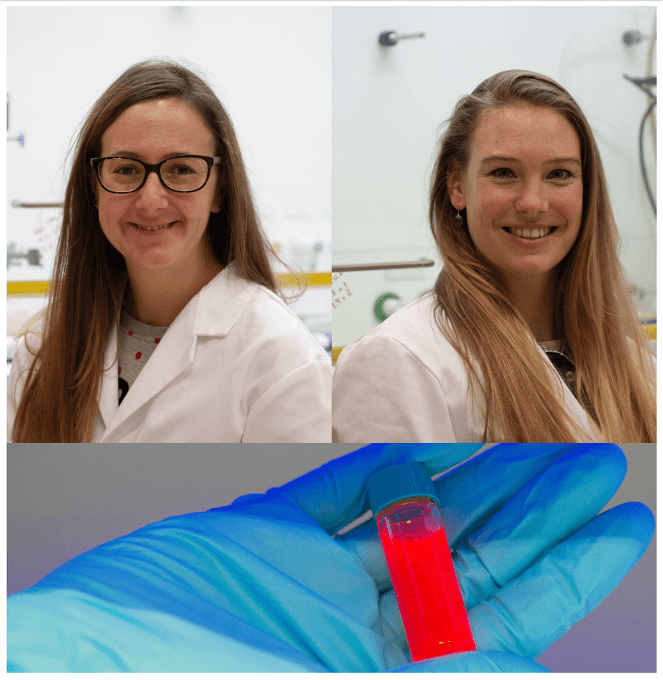Oct 12 2018
Perovskites are a unique group of crystals that possess several potential properties for use in nanotechnology.
However, carrier multiplication—an effect that renders materials much more efficient in changing light into electricity, is a desirable property that has not been observed in these materials before.
A new study carried out in association with Osaka University (OU and the University of Amsterdam (UA) and headed by professor Tom Gregorkiewicz (UA, OU) and professor Yasufumi Fujiwara (OU), has demonstrated the prescence of carrier multiplication in certain perovskites for the first time.
 Dr. Leyre Gomez (right) and Dr. Chris de Weerd (left) with a sample of the studied material. (Credit: the University of Amsterdam)
Dr. Leyre Gomez (right) and Dr. Chris de Weerd (left) with a sample of the studied material. (Credit: the University of Amsterdam)
Crystals are configurations of ions, atoms, or molecules that are well-arranged in a structure which repeats itself in all directions.
Some crystals have been encountered in day-to-day life: some examples include diamond, ordinary salt, and even snowflakes.
Maybe, what is not well-known is that some crystals have highly interesting properties when their size is that of nanometers—a few billionths of a meter—and not that of everyday life. There, one ventures into the realm of nanocrystals—structures that have demonstrated to be very useful in building technological applications at very small scales.
Perovskites were named after Lev Perovski, the 19th-century Russian mineralogist. These materials form a specific family of nanocrystals whose crystal structure is the same.
These perovskites, at the nanoscale, possess many interesting electronic properties, which make them handy for designing, for instance, lasers, solar cells, TV-screens, and LEDs. This is the reason why physicists have extensively studied perovskite nanocrystals in the past few years.
Carrier multiplication
Carrier multiplication is a property which had not been demonstrated to exist in perovskites till date.
When light energy is converted into electricity by nanocrystals—in solar cells, for instance—this is often done one particle at a time: one infalling photon leads to one excited electron (and the equivalent “hole” where the electron used to be) carrying an electrical current.
Yet, in some materials, if the infalling light is sufficiently energetic, it is possible to excite additional electron-hole pairs as a consequence; it is this process that is called carrier multiplication.
When carrier multiplication takes place, it would become much more efficient to convert light energy into electricity.
For instance, in normal solar cells, there is a hypothetical limit (the supposed Shockley-Queisser limit) on the amount of energy that can be transformed in this manner: at the most, some 30% of the solar power gets converted into electrical power. However, in materials that show the carrier multiplication effect, up to 44% efficiency has already been achieved.
This also makes it quite interesting to look for the carrier multiplication effect in perovskites, and that is exactly what Dr. Leyre Gomez and Dr. Chris de Weerd from the Optoelectronic Materials group have presently done.
The study was headed by professor Tom Gregorkiewicz, in association with the group of professor Yasufumi Fujiwara, along with support of their coworkers from Technical University Delft and the National AIST Institute in Tsukuba.
The researchers used spectroscopic techniques—examining the radiation frequencies that arise from a material after fleetingly illuminating it with a flash of light—and demonstrated that a perovskite nanocrystals designed from iodine, lead, and cesium indeed show carrier multiplication.
In addition, the team argued that this effect‘s efficiency is greater than reported so far for any other types of materials; Thus, with this recent finding, perovskite’s unique properties get a new boost!
Until now, carrier multiplication had not been reported for perovskites. That we have now found it is of great fundamental impact on this upcoming material. For example, this shows that perovskites can be used to construct very efficient photodetectors, and in the future perhaps solar cells.”
De Weerd